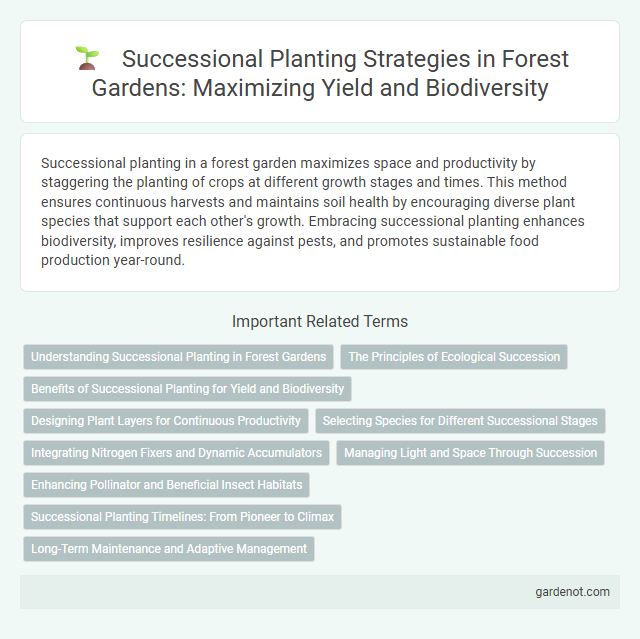Successional planting in a forest garden maximizes space and productivity by staggering the planting of crops at different growth stages and times. This method ensures continuous harvests and maintains soil health by encouraging diverse plant species that support each other's growth. Embracing successional planting enhances biodiversity, improves resilience against pests, and promotes sustainable food production year-round.
Understanding Successional Planting in Forest Gardens
Successional planting in forest gardens maximizes space and productivity by strategically sequencing plant species based on their growth rates and ecological roles. Early colonizers, such as nitrogen-fixing shrubs and fast-growing annuals, improve soil fertility and microclimate, paving the way for slower-growing perennials and canopy trees. This dynamic layering mimics natural forest succession, fostering biodiversity, resilience, and continuous harvest throughout the seasons.
The Principles of Ecological Succession
Successional planting in forest gardens harnesses the principles of ecological succession by mimicking natural plant community progressions to improve soil health and biodiversity. Early pioneer species in successional planting stabilize the environment and create conditions for later, more shade-tolerant plants, enhancing long-term ecosystem resilience. Applying these principles supports the creation of layered, self-sustaining plant systems that optimize nutrient cycling and habitat complexity.
Benefits of Successional Planting for Yield and Biodiversity
Successional planting in forest gardens enhances continuous yield by staggering crop maturity throughout the growing season, ensuring a steady supply of fruits, nuts, and vegetables. This method promotes biodiversity by creating diverse microhabitats and supporting various pollinators and beneficial insects across different growth stages. The increased plant diversity also improves soil health and resilience against pests and diseases, sustaining long-term productivity.
Designing Plant Layers for Continuous Productivity
Successional planting in forest gardens utilizes carefully designed plant layers, including canopy trees, understory shrubs, herbaceous perennials, and ground covers, to maximize space and extend harvest periods throughout the year. By selecting species with staggered fruiting times and complementary growth habits, forest gardens ensure continuous productivity without resource competition. Integrating nitrogen-fixing plants and deep-rooted species further enhances soil fertility and resilience, supporting long-term ecosystem health and yield stability.
Selecting Species for Different Successional Stages
Successional planting in forest gardens involves selecting species that thrive at various growth stages to ensure ecosystem stability and productivity. Early successional species like nitrogen-fixing trees prepare the soil, while mid-successional shrubs and fruiting plants foster biodiversity and food production. Late successional trees provide canopy cover and long-term habitat, creating a dynamic and resilient forest garden system.
Integrating Nitrogen Fixers and Dynamic Accumulators
Successional planting in forest gardens enhances soil health and productivity by integrating nitrogen-fixing plants such as clover, alder, and goumi, which enrich the soil with essential nitrogen through symbiotic bacteria. Incorporating dynamic accumulators like comfrey and yarrow improves nutrient cycling by mining deep soil minerals and making them accessible to shallow-rooted plants. This strategic layering supports continuous growth and resilience, fostering a self-sustaining ecosystem rich in biodiversity and soil fertility.
Managing Light and Space Through Succession
Successional planting in forest gardens maximizes light and space by strategically sequencing plant species according to their growth habits and canopy layers. Fast-growing pioneer plants provide initial shade and nutrient buildup, followed by slower-growing, shade-tolerant species that thrive under the established canopy. This dynamic layering optimizes photosynthesis efficiency, soil health, and overall productivity throughout the garden's life cycle.
Enhancing Pollinator and Beneficial Insect Habitats
Successional planting in forest gardens creates continuous blooms and diverse plant structures that support pollinator populations year-round. Integrating native flowering species and nectar-rich plants attracts beneficial insects like bees, butterflies, and predatory beetles, enhancing ecosystem health. This method boosts pollination efficiency and natural pest control while maintaining soil fertility through dynamic plant layering.
Successional Planting Timelines: From Pioneer to Climax
Successional planting in forest gardens follows a strategic timeline beginning with pioneer species like legumes and fast-growing nitrogen-fixers that prepare the soil and microclimate. Mid-succession plants, including fruit trees and shrubs, establish a canopy that supports biodiversity and soil health. Finally, climax species such as hardwoods create a stable, mature ecosystem that sustains long-term productivity and resilience.
Long-Term Maintenance and Adaptive Management
Successional planting in forest gardens promotes biodiversity and resilience by introducing plant species in stages according to their growth rates and ecological roles. Long-term maintenance requires regular monitoring of plant health, soil conditions, and light availability to adjust species composition and spacing effectively. Adaptive management strategies integrate observational data and evolving ecosystem dynamics to optimize productivity and sustainability over time.
Successional planting Infographic

 gardenot.com
gardenot.com